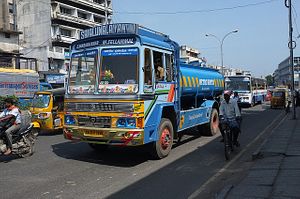Having worked as a tour leader in India and Nepal nearly every season for 10 years it was impossible for me not to develop a habit of scribbling down the things I saw written on the trucks (which our buses were forced to follow for long hours). And it would be foolish to think that I am the only one in the universe doing this. Both the artwork and the mottos found on Indian trucks are currently taken note of not only in newspapers and movies (that much is hardly new) but in books, in the Internet and even in academic work.
However pot-holed and dusty an Indian road may be, a goods truck plying it must be painted with vivid colors and adorned to a point of wiping out any risk of horror vacui. Many of these vehicles are also provided with special protection to ward off the effects of the evil eye. An old black shoe – a real one dangling between the back wheels or a painted one above the wheels – is one of the solutions said to keep off the dangerous magic of jealousness. A small lemon and a few green chili peppers may be attached to feed Alakshmi, the goddess of misfortune. But there are also words, phrases and sentences written all over the truck, some of them curious, some funny – and some witty.
An ubiquitous phrase will be “Horn Please” or “Blow Horn” painted at the rear, often with an “OK” added in such a place that it looks like “Horn OK Please” (as drivers are expected to honk before overtaking). Other phrases will also refer to driving rules, such as “Wait for Side” or “Use Dipper at Night” (occasionally misspelled as “Use Diaper at Night”). Another category will be phrases pointing out to the driver’s nostalgia for home, such as “Ghar Kab Aoge?” (“When will you come home?”). And as it is hard to achieve anything in life without Mom, the phrase “Mother’s Blessing” is another common one, in both India and Nepal.
Moreover, just as with sailors and their ships, some words point out that the truck is a she, the only woman accompanying the driver during the long days of his strenuous journey. One can for example find cars called “Jat ki Sherni” (“The Tigress of a Jat” – Jat being a particular community). You can often guess not only the truckers ethnic and linguistic community but his religious affiliation. Images of gods and godheads are painted all over cars of the Hindus, while Muslims may ask the painter to write the number 786 and the image of Kaaba in Mecca.
Despite these differences, another common theme will be the patriotism and love of country. In the Hindi-speaking areas one of the popular phrases is “Mera Bharat Mahaan” (“My India is Great”) although a few rhyme it with a few more words: “100 mein se 99 beiman” (“99 out of 100 people are dishonest”). Love is obviously another frequent topic and sometimes even references to safe sex and family planning can be found in slogans such as “Protect yourself from AIDS” or “We are two, we have two [kids].” Naturally, a lot of mottos ponder about life and its general rules and are often quotations. Two instances can be “Go on, earn a lot diamonds and pearls, the pocket is empty in the grave” or “I gave the gold to the goldsmith, he made a bangle out of it, I have my heart to my lover, he/she made me crazy.”
The words written on the trucks are also believed to help in warding off the evil eye. The whole concept of this belief rests on an assumption that if somebody glances at our possession with jealousness some calamity may befall our things (or the people close to us). The trucks therefore usually address “those looking with the evil eye” (buri nazar vale) in a number of ways, the most common sentence being “Those looking with the evil eye, your face is black”. Yet, my favorite in this category is “Those looking with the evil eye, you also have good [things].” And out of phrases of religious character the one I like best – though it would be found more often on country tractors than trucks – is “Kam hi puja hai” (loosely translated as “Work is the best form of worship”).
Truck art has attracted the attention of many people, including the photographer Dan Eckstein, who last year published a book titled Horn Please: The Decorated Trucks of India. Another example is the Horn Please documentary, done (despite the shared name) by other people and available here. And among the recent dissertations on this topic one finds Ashima Madan’s Truck Art in India: Reflecting on Ideas of Public Space and Sub-culture. The same person also runs a Facebook page called Wisdom on Wheels.
To sum up, it is hardly surprising that truck art and truck mottoes have attained popularity. After all, an Indian truck is in a way a miniature of India: It expresses the driver’s attachment to his family and values, his community and religion, his concern about working out the rules of cooperating with other people, his country’s rising population and corruption, among other thoughts. And, just like India, despite the condition of the road the truck always looks cheerful and continues its onward journey.

































